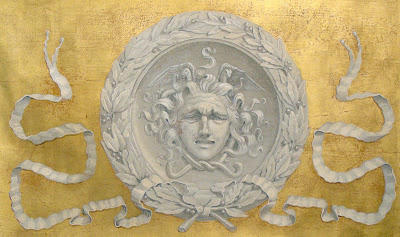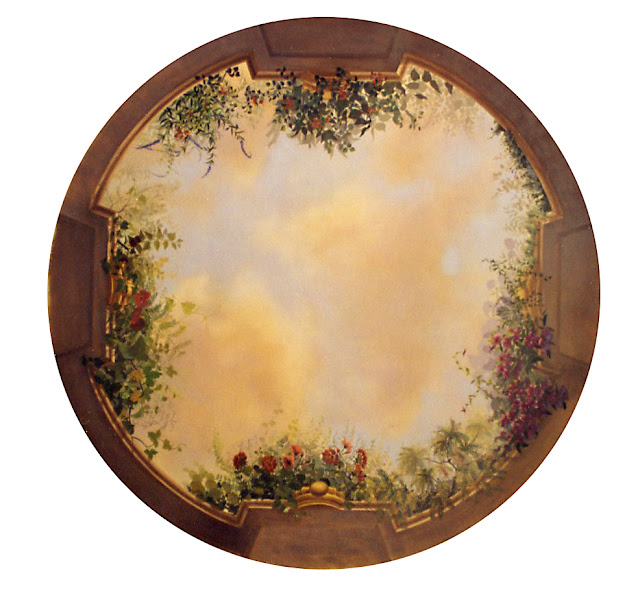So, at this point (after painting the library and the Pompeian room ceilings; see previous posts) it's beginning to look like the never ending job, especially after we've walked through the rest of the house and outlined projects for other rooms, some of which aren't even constructed. My client is never short of inspiration, and he's a very good designer himself, so we've had numerous ideas for hallways, bedrooms, grottoes, etc.,
This was a design for an outdoor terrace floor to be done in terrazo- it has not been executed yet. I'm wondering now if it might be attempted in colored concrete of some kind.
We began designs for the hallway outside the upstairs bedrooms around this point I think, though it's sometimes hard to remember what came first with so many overlapping ideas. I have also kept my outside art projects going through some periods of this house, and at this time I was preparing for a show of watercolors at the Torrance Art Museum, so the sequence gets a bit blurry to me at times. Anyways, here's one of the sketches I did for the hallway ceiling in a French grotesque style.
We shifted focus to the master bedroom at this point and this design was never used, but it was a fun learning experience to do it.
The master bedroom is French neo-classical in the style of Percier et Fontaine; grisaille ornament on a gold leaf background and paneled all around. Here's the layout for it.
It also has not been constructed yet, so the work, which I completed 3 or 4 years ago, is sitting in my studio all rolled up and waiting for the day that the doors get moved and the panel moldings go up, so that they can be attached and gleam. The over door panels each have bas relief portrait busts in a classical mode, including Napoleon and Josephine, and a single image of Medusa, seen here:
The long narrow panels that flank the doors and windows are based on Giovanni da Udine's ornament for the "Raphael loggia" at the Vatican. Detail of it seen here:
I can't wait for this room to be installed- I think it will be quite stunning!
After this room came the loggia (covered porch) which connects the three upstairs bedrooms. It had to be created by joining and expanding 3 smaller and enclosed porches into one long space. This left it with three bays divided by support beams; each bay is 7 feet by 12 feet and about one foot deep. The theme for this area is Adam and Eve, so I designed a trompe l'oeil trellis pattern with some depth, covered in apple tree branches and numerous birds as per my client's request. I did a barrel vault for the two side panels, and figuring out the curving hexagonal pattern was very tricky. I did not use Photoshop this time around, although I probably could have. This is one of the side panels:
And here's a little detail where you can see how I painted the sky over a raw sienna background so that you can see the underpainting showing through and giving the strokes some texture. The whole mural will be glazed darker and then sanded through to give it an aged effect after it has been mounted on the ceiling- if that ever happens! Actually, it's looking like we're getting closer now, having finished some of the construction hurdles such as putting the tiles on the roof.
This was a design for an outdoor terrace floor to be done in terrazo- it has not been executed yet. I'm wondering now if it might be attempted in colored concrete of some kind.
We began designs for the hallway outside the upstairs bedrooms around this point I think, though it's sometimes hard to remember what came first with so many overlapping ideas. I have also kept my outside art projects going through some periods of this house, and at this time I was preparing for a show of watercolors at the Torrance Art Museum, so the sequence gets a bit blurry to me at times. Anyways, here's one of the sketches I did for the hallway ceiling in a French grotesque style.
We shifted focus to the master bedroom at this point and this design was never used, but it was a fun learning experience to do it.
The master bedroom is French neo-classical in the style of Percier et Fontaine; grisaille ornament on a gold leaf background and paneled all around. Here's the layout for it.
It also has not been constructed yet, so the work, which I completed 3 or 4 years ago, is sitting in my studio all rolled up and waiting for the day that the doors get moved and the panel moldings go up, so that they can be attached and gleam. The over door panels each have bas relief portrait busts in a classical mode, including Napoleon and Josephine, and a single image of Medusa, seen here:
The long narrow panels that flank the doors and windows are based on Giovanni da Udine's ornament for the "Raphael loggia" at the Vatican. Detail of it seen here:
I can't wait for this room to be installed- I think it will be quite stunning!
After this room came the loggia (covered porch) which connects the three upstairs bedrooms. It had to be created by joining and expanding 3 smaller and enclosed porches into one long space. This left it with three bays divided by support beams; each bay is 7 feet by 12 feet and about one foot deep. The theme for this area is Adam and Eve, so I designed a trompe l'oeil trellis pattern with some depth, covered in apple tree branches and numerous birds as per my client's request. I did a barrel vault for the two side panels, and figuring out the curving hexagonal pattern was very tricky. I did not use Photoshop this time around, although I probably could have. This is one of the side panels:
And here's a little detail where you can see how I painted the sky over a raw sienna background so that you can see the underpainting showing through and giving the strokes some texture. The whole mural will be glazed darker and then sanded through to give it an aged effect after it has been mounted on the ceiling- if that ever happens! Actually, it's looking like we're getting closer now, having finished some of the construction hurdles such as putting the tiles on the roof.
Next up: Restoring the living room ceiling!




































